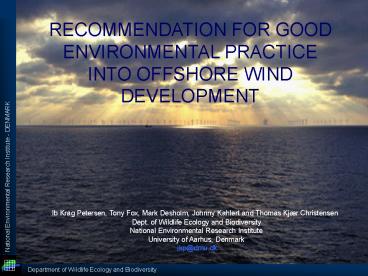NERI 2002, Oragnisation and keyfigures - PowerPoint PPT Presentation
1 / 28
Title:
NERI 2002, Oragnisation and keyfigures
Description:
NERI 2002, Oragnisation and keyfigures – PowerPoint PPT presentation
Number of Views:51
Avg rating:3.0/5.0
Title: NERI 2002, Oragnisation and keyfigures
1
RECOMMENDATION FOR GOOD ENVIRONMENTAL
PRACTICE INTO OFFSHORE WIND DEVELOPMENT
Ib Krag Petersen, Tony Fox, Mark Desholm, Johnny
Kahlert and Thomas Kjær Christensen Dept. of
Wildlife Ecology and BiodiversityNational
Environmental Research Institute University of
Aarhus, Denmark ikp_at_dmu.dk
2
Shorebird Flyways
3
(No Transcript)
4
Defining the problem
- Which are the key species?
- What are the hazards?
- How can we assess the local effects?
5
Which are the key species?
- Those for which the area is important at some
stage in the annual life cycle - Those which enjoy special protection measures
- Those that are for some reason vulnerable to
development - Those showing characteristics that make them
vulnerable to windfarms - Those that exhibit high annual adult survival
and low reproductive output - Most emphasis therefore on long-lived waterbirds
6
What are the hazards?
- Avoidance response
- - Displacement to movement
- (lateral)
7
What are the hazards?
- Avoidance response
- - Displacement to movement
- (altitudinal)
8
What are the hazards?
- Avoidance response
- - Effective habitat loss
9
What are the hazards?
- Avoidance response
- - Effective habitat loss
10
What are the hazards?
- Habitat loss/gain
- - less than 1
- of the total area
11
What are the hazards?
- Collision rate
12
What are the hazards?
- Avoidance response
- - Displacement to movement
- - Effective habitat loss
- Habitat loss/gain
- Collision rate
13
Displacement of movement
- measure flight trajectories in 3 dimension
space - compared pre- and post- construction flight
trajectories
14
Displacement of movement
- autumn migration of land birds
- autumn migration of waterbirds
- spring migration of waterbirds
15
Displacement of movement
16
Habitat loss/gain
- Behavioural response (effective habitat loss)
- Physical habitat loss (under foundations and
anti-scour) - Physical habitat gain (foundations and
anti-scour)
17
Habitat loss/gain
18
Habitat loss/gain
- Wind farm area
- 2 km strip outside
- Area 2-4 km outside
19
Habitat loss/gain
20
Collision rate
- Pre-construction modelling
- Post construction monitoring (validation)
21
Collision rate
- Pre-construction modelling
22
Collision rate
- Pre-construction
- modelling
23
Collision rate
- Pre-construction modelling
24
Collision rate
- Thermal
- Animal
- Detection
- System
- (TADS)
25
Collision rate
Post construction monitoring
26
VISUAL STIMULUS AVOIDANCE RESPONSE
PHYSICAL HABITAT LOSS/MODIFICATION
COLLISION MORTALITY
Hazard factor
Physical effects
Ecological effects
Energetic costs
Fitness consequences
Changes to overall population size
Population impacts
27
BEST PRACTICE?
- Strategic overview that facilitate overall site
selection for offshore wind farm development - The EIA process address the situation for a
specific site - Post-construction monitoring will quantify
predictions from EIAs and generate generic
results for the general public - Cumulative effects need to be managed by a more
general body than the individual EIA process.
28
Thank you for your attention



















![[Sarmiento and Gruber, 2002] PowerPoint PPT Presentation](https://s3.amazonaws.com/images.powershow.com/5549762.th0.jpg?_=202012240810)











